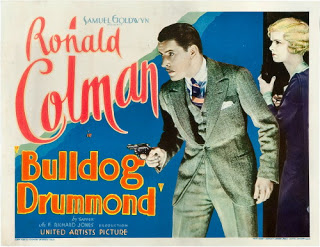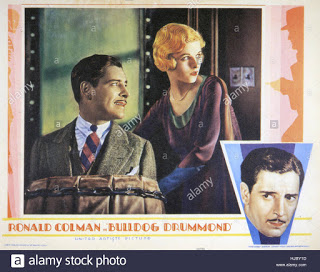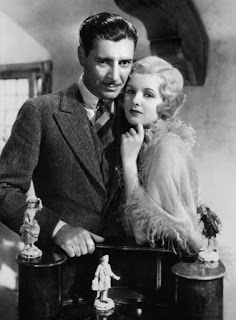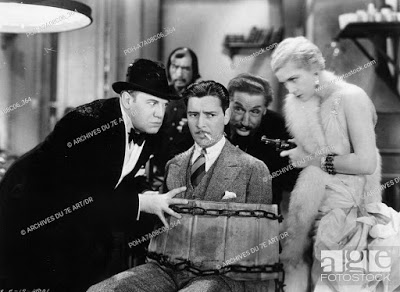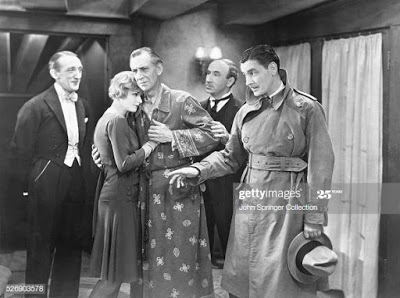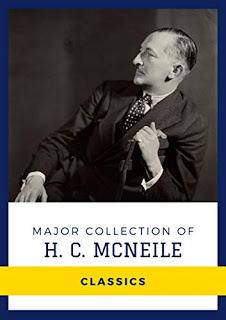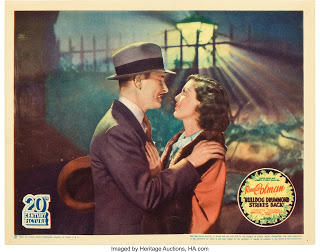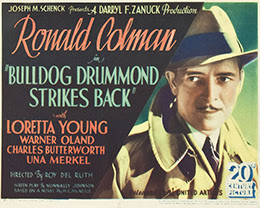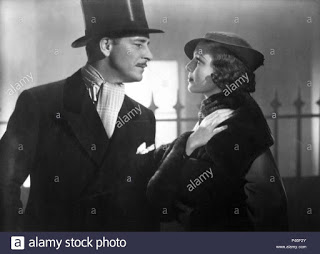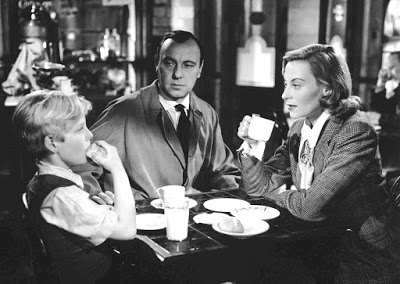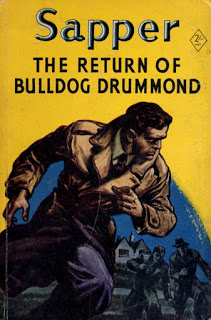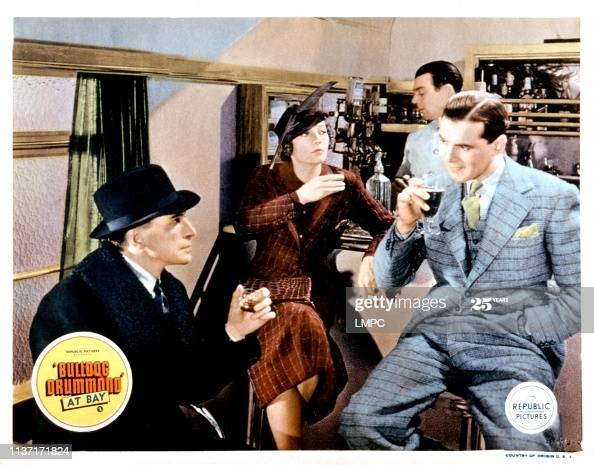Bulldog Drummond - 1929
- 1937
Bulldog Drummond
(1929) - 7.5
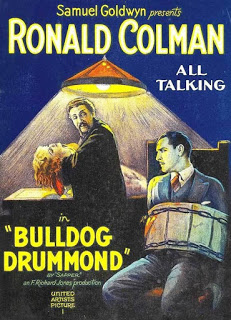
Samuel Goldwyn (the G in MGM), head of the Samuel Goldwyn Productions, wanted
to venture into talkies and was looking for the right vehicle. He latched
on to the adventurous Bulldog Drummond. There had been two silent films about
Bulldog but this was to be the first with sound. Bulldog Drummond was the
hero of the books from Herman Cyril McNeile who published the first one in
1920 under the pseudonym of Sapper, an engineer in the military. McNeile
had been in the field during WWI and being gassed was attributed as the cause
for his death in 1937 from throat cancer. In total, he wrote ten Bulldog
novels and numerous films were made - the last two in the 1960s. Paramount
was to have a long series of them in the 1930's.
In the books Drummond was a captain in the war and now that the war is over
he is at a loss of what to do - so he becomes an adventurer - trying to right
wrongs - sometimes with his friends called The Black Gang. Some have accused
Drummond and by association McNeile of being a fascist as this gang often
fought against agents of the Reds and used methods that were not lawful to
do so. His main nemesis is Carl Peterson which is carried over to a few movies.
In the first book Peterson is attempting a Communist coup in England. The
only Drummond film I have seen that sort of captures this political and vigilante
angle is the 1934 The Return of Bulldog Drummond with Ralph Richardson in
the role. In this film, Peterson makes an appearance but as a much more mundane
criminal or blackguard as he is called.
Goldwyn also wanted to find out how well Ronald Colman played in a talkie.
He had been in silent films since the beginning of the decade but like all
the other silent stars they had to see how the audience responded to their
voice. Well, he is Ronald Colman with one of the best voices ever in films
- his smooth, upper class but not too upper class English accent went over
like gangbusters. The film and Colman was a big success and it set him up
for heroic films like Raffles, Clive of India, The Tale of Two Cities, Lost
Horizon and The Prisoner of Zenda over the next decade. As the female of
interest was an actress who also had to be tested - Joan Bennett - with her
bobbed hair and small face and overacting. I guess she did well enough as
the damsel in distress - but she had much better days ahead of her.
For a 1929 sound film, this is remarkably well done (with a few exceptions)
that integrates the style of the silent horror films and a snappy modern
swashbuckler adventure tale. Once it gets started it rarely slows down and
Colman as the super confident debonair witty hero is about perfect. He was
Cary Grant before there was a Cary Grant. The designs by William Cameron
Menzies and the cinematography from Greg Toland give the film a horror sheen
with a gothic styled house that Baron Frankenstein would be happy to live
in; long winding stairs, a torture room, a basement full of hooligans and
a giant skylight all in shadows Throw in three insane psychos each creepier
than the next make for a film that could have been a straight out horror
if they had wanted to go that way. This one scene between two of them when
Peterson kisses the woman passionately - she is like a snake shedding its
skin - then strangles her near to death only to end up kissing her again
is wonderfully perverse.
Drummond is bored. As he tells his friend Algy (Claud Allister who shows
up in a few Drummond films) "I am too rich to work. I am too intelligent
to play". He wants adventure and so puts an ad in a newspaper saying just
that. A woman Phyllis contacts him telling him to meet her at midnight in
a hotel out of town. He does and she tells him that her wealthy uncle is
being held prisoner by Peterson (Montagu Love) and two others. They want
to get his money. From this point on the film is nearly in full motion as
Drummond rescues the uncle, the girl and himself a few times. A bit of a
serial like atmosphere.
The only things that bring the film down a few notches is Algy is a bit of
a twit - the deadly comic relief that so many films like this insisted on
- at one point Drummond tells him that "if I needed a bodyguard I would have
sent for my maiden aunt. She is more of a man than you". Not kind but close
to the target. And Bennett is pretty bad here - useless in times of danger,
this tiny little voice, faints and yet Drummond has to fall in love with
her because of the script. The film did very well and Drummond was on his
way to becoming a film regular though only one more time with Colman.
Bulldog Drummond Strikes Back (1934) - 6.0
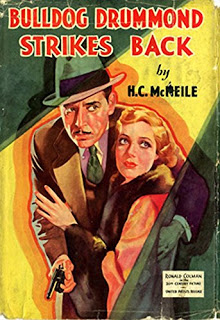
This is the second and last Ronald Colman performance as Bulldog Drummond
produced by 20th CenturyFox. Fox had contracted for two Bulldog films and
the first one Temple Tower in 1930 with Kenneth MacKenna had bombed at the
box office and so they signed up Colman to play him. Now in the same year
over on the other side of the pond in England a competing Bulldog Drummond
film was produced and starred Ralph Richardson. So it can get a bit confusing
if one tries in any way to follow the narrative arc of the Bulldog Drummond
films.
At this point the Drummond films are still top of the shelf films and there
is a fair amount of talent in this one beginning of course with Ronald Colman
who had been a star since the silent period. Throw in some additional cast
members such as Loretta Young, Warner Oland taking a break from Charlie Chan
to play the villain, C. Aubrey Smith, E.E. Clive, Mischa Auer still doing
small roles, Una Merkel and apparently Lucille Ball as an extra though I
admit to not noticing that.
There is some talent behind the camera as well - Roy Del Ruth who has over
100 directorial credits from 1920 to 1960; Nunnally Johnson is the script
writer very close to the beginning of his illustrious career where he racked
up credits on such films as The Grapes of Wrath, The Desert Fox and How to
Marry a Millionaire; the veteran cinematographer J. Peverell Marley who makes
the film look like a noir and the music comes from the mind of Alfred Newman
who is a legend as well. Not too shabby. And all for a Bulldog Drummond film.
On a chilly foggy night in London, Drummond gets lost and goes in search
of someone in an old house to tell him where he is - instead he finds a dead
body and is on another adventure of sorts in which Loretta Young looking
ravishing is the damsel in distress and Warner Oland is the villain trying
to do great harm to the city - all played out in the shadows of Marley's
cinematography.
I watched this on the daily motion web site and thus not under the best circumstances.
The Return of Bulldog Drummond (1934) -
7.0
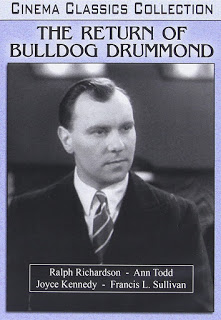
Interestingly, this film seems to follow on the heels of the 1929 Bulldog
Drummond that starred Ronald Colman and was produced by Goldwyn in America.
Yet this one stars Ralph Richardson and was made in the UK by British International
Pictures. The one connective tissue is the character of Drummond's friend
Algy who was played by Claude Allister in both films - he was also to play
Algy in the 1937 Bulldog Drummond at Bay. More often than not Algy was played
by Reginald Denny in a number of films in the series.
Ralph Richardson, who was to become one of England's greatest actors, was
just at the beginning of his career and actually gets billed third behind
Ann Todd and Joyce Kennedy who are both barely in the film. Richardson is
of course Drummond and a fine Bulldog Drummond he makes - all charm and whimsy.
At the end of the 1929 film Drummond has saved the girl and defeated Carl
Peterson and here a few years later he is retired, married to the woman he
saved and again at odds with Peterson and his wife Irma. In the books Peterson
is Drummonds nemesis in many of them.
Here Peterson is a saboteur/ propagandist in the pay of the munition's industry
spreading fake news by getting stories into newspapers that foment war and
he also kills members of the peace movement. Drummonds and his band of merry
makers (The Black Gang) are out to stop them. It is a quick moving crisp
little adventure that is quite enjoyable. It reminded me slightly in pace
and tone of The 39 Steps though director Summers is certainly no Hitchcock.
The portly actor who plays Peterson, Francis L Sullivan, has one of most
marvelous deep mellifluous voices I can think of - sort of George Sanderish
but deeper.
Bulldog Drummond
at Bay (1937) – 6.0
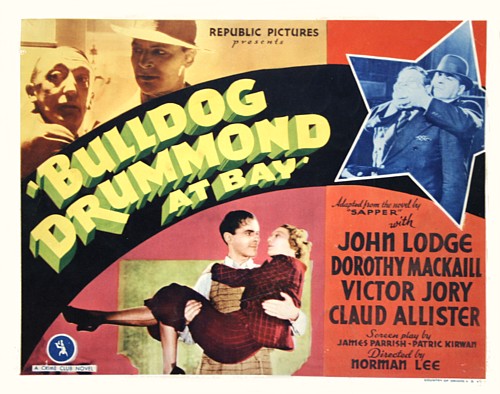
Just as the Paramount series was getting started in America with John Howard
as the title character, the British once again decided to make their own
Drummond film as they had with The Return of Bulldog Drummond in 1934. This
one was produced by Associated British Pictures and was distributed in the
USA by Republic whose name is on the DVD that I saw. This has no particular
connection to any of the previous story threads or the Paramount ones other
than unfortunately having the annoying Claude Allister play Algy, Drummond's
loyal but simpering friend as he had in Bulldog Drummond (1929) and The Return
of Bulldog Drummond. In the Paramount films the honor of playing Algy was
to go to Reginald Denny who is slightly more tolerable than Claude.
This isn't too bad - it has a sniff about it like a Hannay film or book as
Bulldog finds himself in the middle of a group of foreign agents trying to
steal the secrets for a radio operated plane (which coincidentally Denny
invented in real life during WWII). The story is full of holes and people
acting rather idiotically but that is sort of par for the course in a one-hour
B film. The bad guys pull that well used but rarely successful ploy of not
killing the hero when they easily could but instead lock him up to die from
poison gas. Drummond chases them through the country and on a train to Scotland
(which perhaps brought Hannay and the 39 Steps to mind) where the head has
a castle.
There is also a femme fatale who comes in the shape of Dorothy Mackaill who
retired after this film only to return decades later in a few episodes of
Hawaiian 5-0, where she was living. Victor Jory gets stuck playing a villain
as he almost always does - and Drummond is portrayed by John Lodge who retired
a few years after this. But then he probably didn't really have to work as
he was a member of the Blueblood Massachusetts family of the Lodges - his
grandfather was Senator Henry Cabot Lodge and his brother was Henry Cabot
Lodge Jr. This Lodge did not do badly after retiring - first joining the
war effort and becoming a colonel and then two terms in the House of Representatives,
a term as Governor of Connecticut and then an Ambassador to Spain. Bulldog
Drummond must have felt a long time gone. Oh, and keep an ear out for a young
Wilfred Hyde-White, who I only noticed because of that distinct voice of
his - playing one of the spies.
